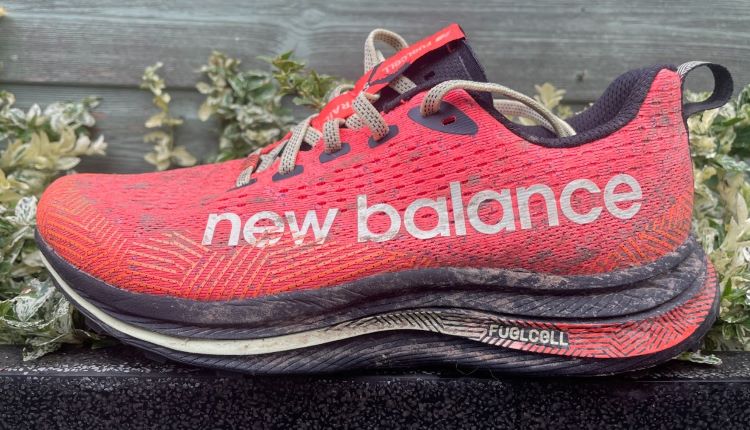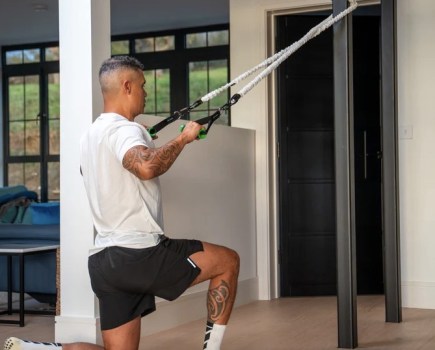New Balance’s SuperComp Trail – the off-road cousin of the racey SC Elite – is a carbon-plated whippet which I reckon has race-winning credentials.
Men’s Fitness verdict
Despite some issues with fit, the New Balance SuperComp Trail is an off-road racing shoe with dependable high-speed performance.- Light and punchy ride
- Good durabiity
- Copes well with road-to-trail transitions
- Short and narrow fit
- Lacks some stability
One of the most important things for a runner is finding the best running shoes for the running you do. The New Balance SuperComp Trail (aka the SC Trail) is a carbon plate-packing trail shoe built for off-road speed. It takes much of its DNA from New Balance’s speedy road racer – the SC Elite – and translates that for the trail.
You get the same light, cushioned and responsive FuelCell foam in the midsole, but with reinforced engineered mesh uppers and stickier Vibram rubber outsoles. I hit the trail with a pair to see if they lived up to the premium price tag.
Why you can trust Men’s Fitness
We spend hours testing every product or service we review, so you can be sure you’re buying the best. Our team of reviewers includes experienced product testers, PTs and fitness writers – as well as the core MF team – who know exactly what sets the best products apart from the rest. The New Balance SuperComp Trail was tested by experienced run product tester Kieran Alger. Find out more about how we test.
New Balance SuperComp Trail design
Put the New Balance SC Trail and SC Elite side by side and they’re clearly from the same family. But while the SC Trail makes use of similar tech, it’s tuned to cope with anything you encounter underfoot.
The midsole features a dual system with two layers of different density FuelCell foam. The first layer close to the foot has the same FuelCell that you’ll find in the FuelCell Elite road racer. That’s New Balance’s most cushioned, responsive foam. But underneath, there’s a tougher, heavier and more resilient FuelCell, to improve stability and durability. Sandwiched in the middle, there’s a forked carbon plate like you’ll find on most of the plated trail shoes.

Up top you’ve got tightly woven and densely engineered mesh uppers with overlays on high abrasion areas and some added toe protection in case you kick rocks or roots.
Flip them over and the Vibram Megagrip Litebase uses rubber that’s 30% lighter and a bit slimmer than full Vibram Megagrip, with 4mm lugs and different grip patterns in the forefoot and heel to provide grip on the climbs and descents.
There are also Flex Grooves to allow the medial and lateral sections of the sole to move independently when they need to and to deliver more flexibility over lumps and bumps.
New Balance SuperComp Trail weight, stack height and drop
At 8.9oz / 253g in a men’s UK 8.5 shoe, the New Balance SC Trail sits among the lighter trail shoes. Not quite the sub-250g stripped-back weight of a Hoka Zinal but shaving a slither off the likes of the carbon-plated Hoka Tecton X2.
They pack a sizable midsole stack with 36.5mm in the heel and 26.5mm in the forefoot, for a generous and protective 10mm drop.
At $199 / £200 it’s fair to say they’re not cheap. However, that’s similar to the Adidas Terrex Agravic Speed Ultra and still considerably cheaper than the Nike UltraFly ($260 / £230).
New Balance SuperComp Trail performance
In testing, I covered close to 50 miles at a mix of paces in the New Balance SC Trail, from ultra-slow and easy through to marathon pace and faster, right up to 5km trail pace. That includes a mixed terrain, road and trail marathon race test.
There’s a lot to like about this shoe. For trail shoes, they feel light, compact and nimble. They’re excellent for picking your way along technical trails with precision.
The midsole is well balanced and there’s a bit of that New Balance SC Elite punch underfoot and more than a smattering of road shoe agility and response. If you liked that road shoe, you might enjoy this too.
New Balance SuperComp Trail protection
There’s just about enough softness from the top layer of FuelCell foam to provide the protection you need, at least up to the marathon distance. Meanwhile the firmer lower layer of foam, with that carbon plate for stiffness, delivers good responsiveness. You still feel connected to the ground in a way you need on the trails, though sometimes on tired legs where I wasn’t landing with as much precision I found they lost some stability.
If you like a bit more cushioned protection under the forefoot, these might be a bit too direct for anything other than shorter, faster efforts. In my marathon test, the tight fit and shorter toe box was a problem, too. You’ll definitely want to size up in these to avoid black toe nails on longer or steeper courses.
New Balance SuperComp Trail verdict
But for runs on mixed terrain, where you might face a combination of compacted forest paths, grass sections, wet and muddy bits and a good chunk of road, this shoe copes remarkably well.
Durability also looks solid. I don’t see any worrying signs of wear after 50 miles and they feel robustly built. The uppers look tear-proof and Vibram Litebase rubber outsoles are strong, too.
One little gripe, though: the Flex grooves that are supposed to help the midsole move with your feet on uneven ground can catch stones. That’s not ideal if you’re racing for time and don’t want to stop and dig them out. That doesn’t stop them being one of our best trail running shoes though.
How we test the best running shoes
Our testers put each shoe through their paces over a mixture of distances and paces to see where they excel, and clocked up significant distances in each one to examine how they wear over time. Each reviewer focused on speed, stability and comfort during test runs, while also assessing the effectiveness of any high-tech features on offer. Their detailed reviews are sure to help you choose the right running shoe for you.
Related content:






